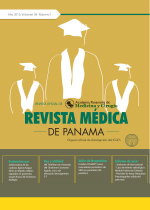Papel De Las Poliaminas En La Transducción De Señales Intracelulares: Posibles Proyecciones De Uso Clínico En El Manejo De Las Distrofias Musculares Por Medio De Su Inhibición Con DMFO.
Autores/as
DOI:
https://doi.org/10.37980/im.journal.rmdp.2019820Resumen
[Polyamines role in intracellular signals transduction: possible projections for clinical use in muscular dystrophies’ management through its inhibition with difluoromethylornithine]
Resumen
Las distrofias musculares de origen genético son muy diversas y, tanto su diagnóstico preciso como su manejo, suponen un reto importante. En cuanto a este último aspecto, no obstante el desarrollo en proceso de nuevas estrategias a nivel molecular para su tratamiento, las herramientas con que se cuenta para este propósito son limitadas, y pocas veces pueden influir de manera efectiva para evitar el deterioro progresivo que muchos de estos pacientes experimentan. Además, las terapias de última generación no abarcan la gran diversidad de estas patologías y no se espera que estén disponibles a corto plazo para la mayoría de los pacientes.
El propósito del artículo es mostrar el papel de las poliaminas, actores ubicuos en el metabolismo intracelular tal vez poco conocidos; cómo están involucrados en los procesos fisiológicos y patológicos, y cómo también pudiesen estar involucrados en la fisiopatología de las distrofias musculares. Su inhibición controlada, mediante Difluorometilornitina (DFMO), pudiese constituir un mecanismo para enlentecer o eliminar el deterioro muscular de estos pacientes, al utilizarse como una herramienta dentro del arsenal de las ya existentes.
Abstract
Muscular dystrophies of genetic origin are very diverse and, both their precise diagnosis and their management represent an important challenge. Regarding this last aspect, despite the development in process of new strategies at the molecular level for its treatment, the tools available for this purpose are limited, and can rarely influence effectively to avoid the progressive deterioration that many of these patients experience. In addition, the latest-generation therapies do not cover the great diversity of these pathologies and are not expected to be available in the short term for most patients.
The purpose of the article is to show the role of polyamines, ubiquitous actors in intracellular metabolism, perhaps little known; how they are involved in physiological and pathological processes, and how they could also be involved in the physiopathology of muscular dystrophies. Its controlled inhibition, by difluoromethylilitin (DFMO), could be a mechanism to slow or eliminate the muscle deterioration of these patients, by being used as a tool within the arsenal of those already existing.
Publicado
Número
Sección
Licencia
Derechos autoriales y de reproducibilidad. La Revista Médica de Panama es un ente académico, sin fines de lucro, que forma parte de la Academia Panameña de Medicina y Cirugía. Sus publicaciones son de tipo acceso gratuito de su contenido para uso individual y académico, sin restricción. Los derechos autoriales de cada artículo son retenidos por sus autores. Al Publicar en la Revista, el autor otorga Licencia permanente, exclusiva, e irrevocable a la Sociedad para la edición del manuscrito, y otorga a la empresa editorial, Infomedic International Licencia de uso de distribución, indexación y comercial exclusiva, permanente e irrevocable de su contenido y para la generación de productos y servicios derivados del mismo. En caso que el autor obtenga la licencia CC BY, el artículo y sus derivados son de libre acceso y distribución.






